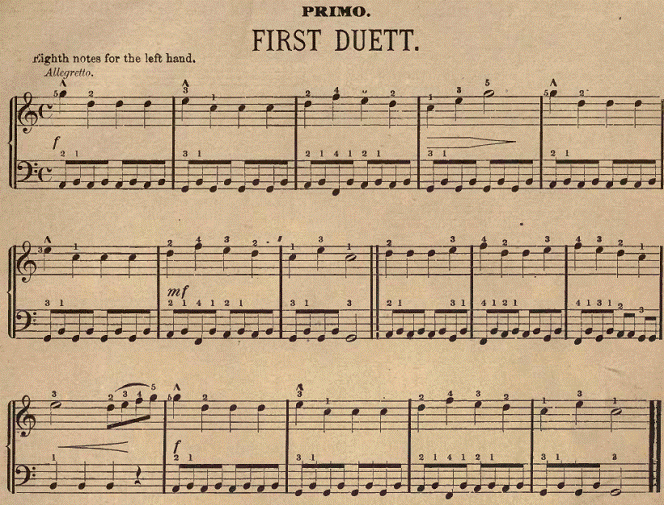How to play a piano melody
Play the melody louder than the bass. As a rule when a melody ascends let it increase in strength, when it descends it should decrease. Aim to play this little melody with as much expression as possible.


In the next exercise, eight notes are introduced. Two eight notes are equal to one quarter note. Strike the first eight notes with the quarter in the left hand and play the next without counting.
If the pupil find it difficult to play the exercise in time, the teacher may introduce the word and, counting one and two and three and four and.
A tie placed over two notes upon different places on the staff means that the second note should be connected as closely as possible with the first note.

Phrases and periods
Music consists of melody and harmony. The former is the more important. We will now briefly examine the construction of a melody; at another time, we shall also learn some lesson in harmony.
The beauty of a melody does not only depend upon the succession of tones, but also upon a correct grouping of measures. By placing heavy and light beats by the side of each other, we obtain a measure, and in a like manner, we group measure into sections, sections into phrase and phrases into periods. The following melody, entitled “Eventide”appears elsewhere in this book.

The first two measures constitute the first section, which is counter- balanced by the second, consisting of the third and fourth measures. The same division takes place in second half of the strain. There are eight measures divided into four sections. Two of them constitute a phrase. Moreover, the two phrases make up a period. The second phrase counter balances the first, just as the last two section of each phrase counter-balance the first two.

A period is a musical sentence, which expresses an idea. The first phrase closes on D, the second on C, the keynote that affords us rest. A period may consist of 16 measures. In the following familiar strain, we see a phrase of six measures. Such phrases are the exception.

All musical compositions are made up of periods, phrases and sections, and in order to properly understand a piece of music we should know how to divide it into periods and phrases. The student should now in a like manner divide not only the second period of this little piece, but every amusement, which is called upon to learn. This practice will afford as better insight into music, and consequently enable the student to play with better comprehension and more perfect expression.


